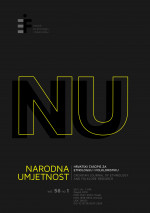SEVDALINKA I ZAGREB DO KRAJA 1950-IH: POKUŠAJ REKONSTRUKCIJE
SEVDALINKA AND ZAGREB UNTIL THE END OF THE 1950S: AN ATTEMPT AT A RECONSTRUCTION
Author(s): Klara Zečević Bogojević, Matea De Bona, Iva Božić, Matija Jerković, Petra Ćaleta, Hana Zdunić, Naila CeribašićSubject(s): Museology & Heritage Studies, Customs / Folklore, Music, Recent History (1900 till today), Sociology of Culture
Published by: Institut za etnologiju i folkloristiku
Keywords: sevdalinka; song; music; Zagreb; history; songbook; radio; discography;
Summary/Abstract: This article documents the presence of sevdalinka songs in Zagreb, and to a degree in the wider Croatian public, until the end of the 1950s. Although sevdalinka is a musical genre characteristic of Bosnia and Herzegovina, it was interwoven into the Croatian cultural imaginary, starting from the middle of the 19th century (or, according to some interpretations, as early as the 16th century). Up to the first decade of the 20th century, the most important sources include popular textual songbooks (by Zagreb bookseller Lavoslav Župan; this songbook was actually a reissue of the Vuk Stefanović Karadžić’s songbook, as well as songbooks by Gjuro Deželić and August Kaznačić), Franjo Kuhač’s folksong collection and collections of musical arrangements by two Croatian musicians working in Sarajevo (Šandor Bosiljevac and Bogomir Kačerovsky), and data from periodicals related to the reception of sevdalinka. Further on, the article analyses the inclusion and contextualization of sevdalinka in the collections by Salih Odobašić, Hamid Dizdar, and Branimir Sakač, which may be taken as paradigmatic of new features of the image of sevdalinka in the period between the two world wars, during the Independent State of Croatia, and in the early years of the socialist Yugoslavia. The next part of the article is dedicated to the presence of sevdalinka in the programs of the Zagreb Radio Station, and in particular to Hamdija Samardžić, who was one of the leading singers of sevdalinka in Zagreb from the late 1930s to the mid-1950s. The most detailed part of the article pertains to the production of sevdalinka by the record industry, beginning with the earliest recordings made in Zagreb for the Gramophone Company 1907–1909 and the sales catalogues of Zagreb’s music store owned by Mavro Drucker, through sevdalinka produced by the Zagreb-based companies Edison Bell Penkala and Elektroton, to sevdalinka produced by the succeeding Zagreb-based company Jugoton from 1947 until the end of 1950, when 78 rpm shellac records were abandoned, and other relevant Yugoslav record companies had appeared. The last part of the article focuses on the example of the sevdalinka “Kradem ti se u večeri” (At night I steal upon you) and examines the complex historical trajectory of this song from the authorial composition of Petar Konjović to a well-known sevdalinka, as well as features of its selected musical interpretations from the 1920s to the present.
Journal: Narodna umjetnost - Hrvatski časopis za etnologiju i folkloristiku
- Issue Year: 56/2019
- Issue No: 1
- Page Range: 149-191
- Page Count: 43
- Language: Croatian

